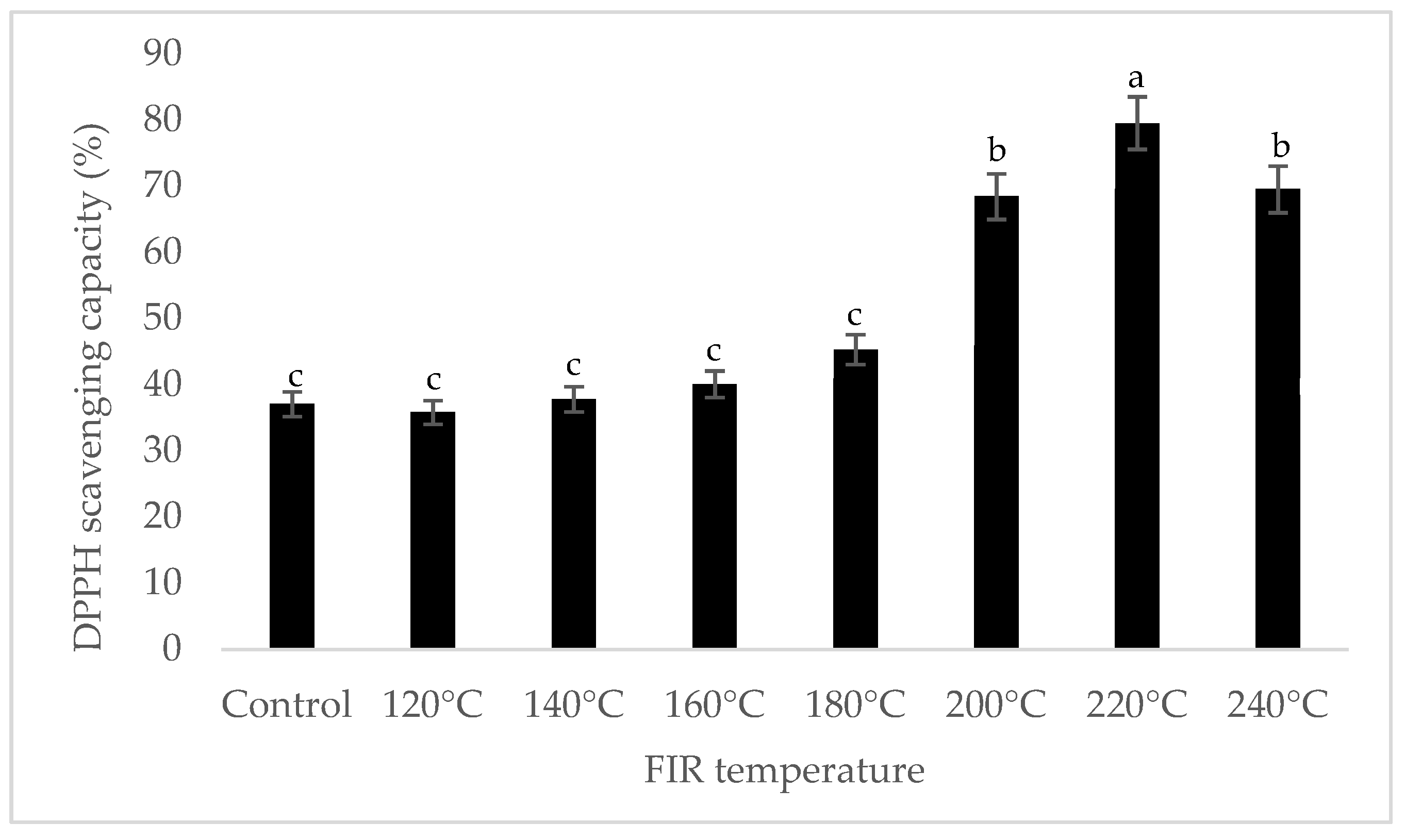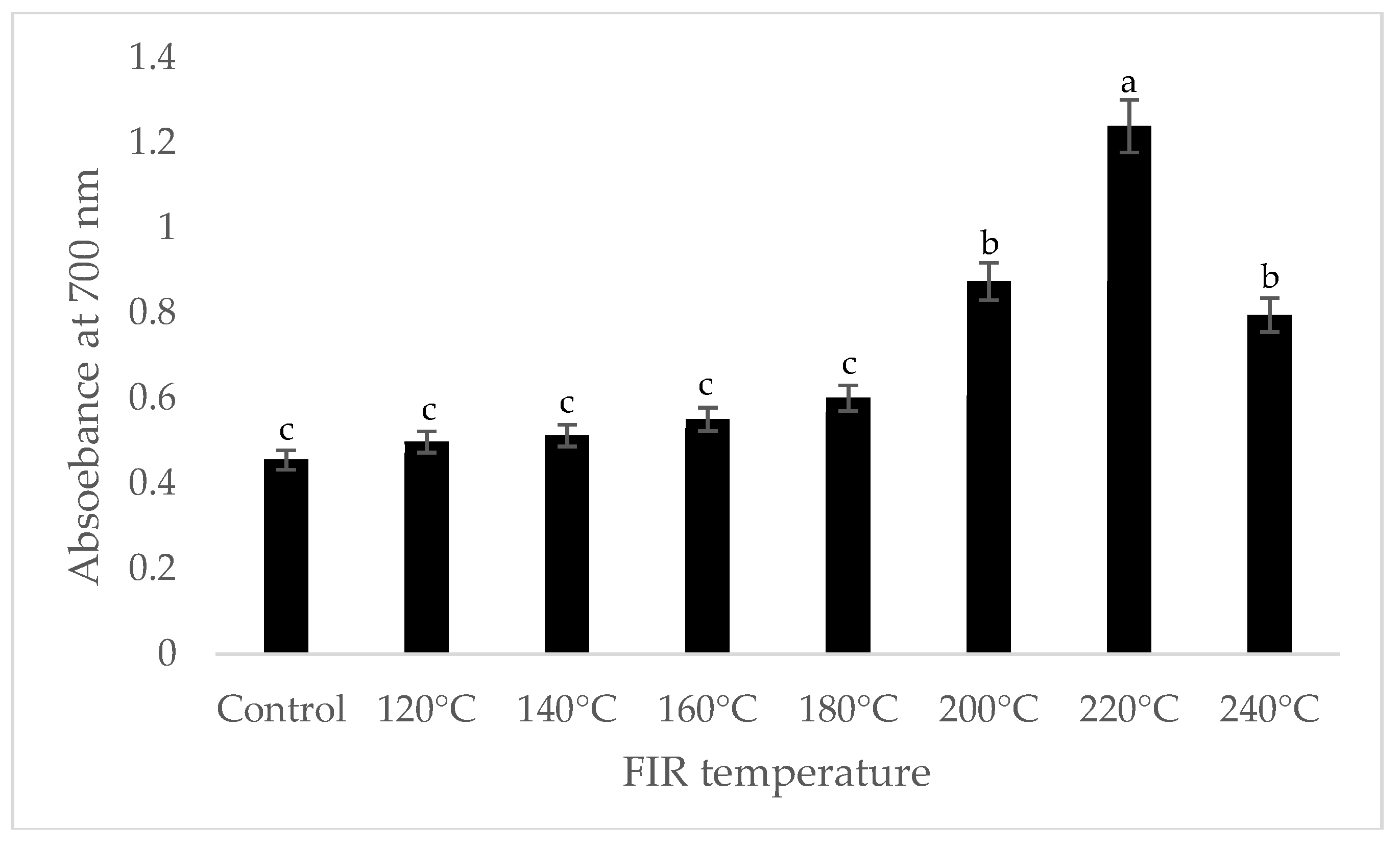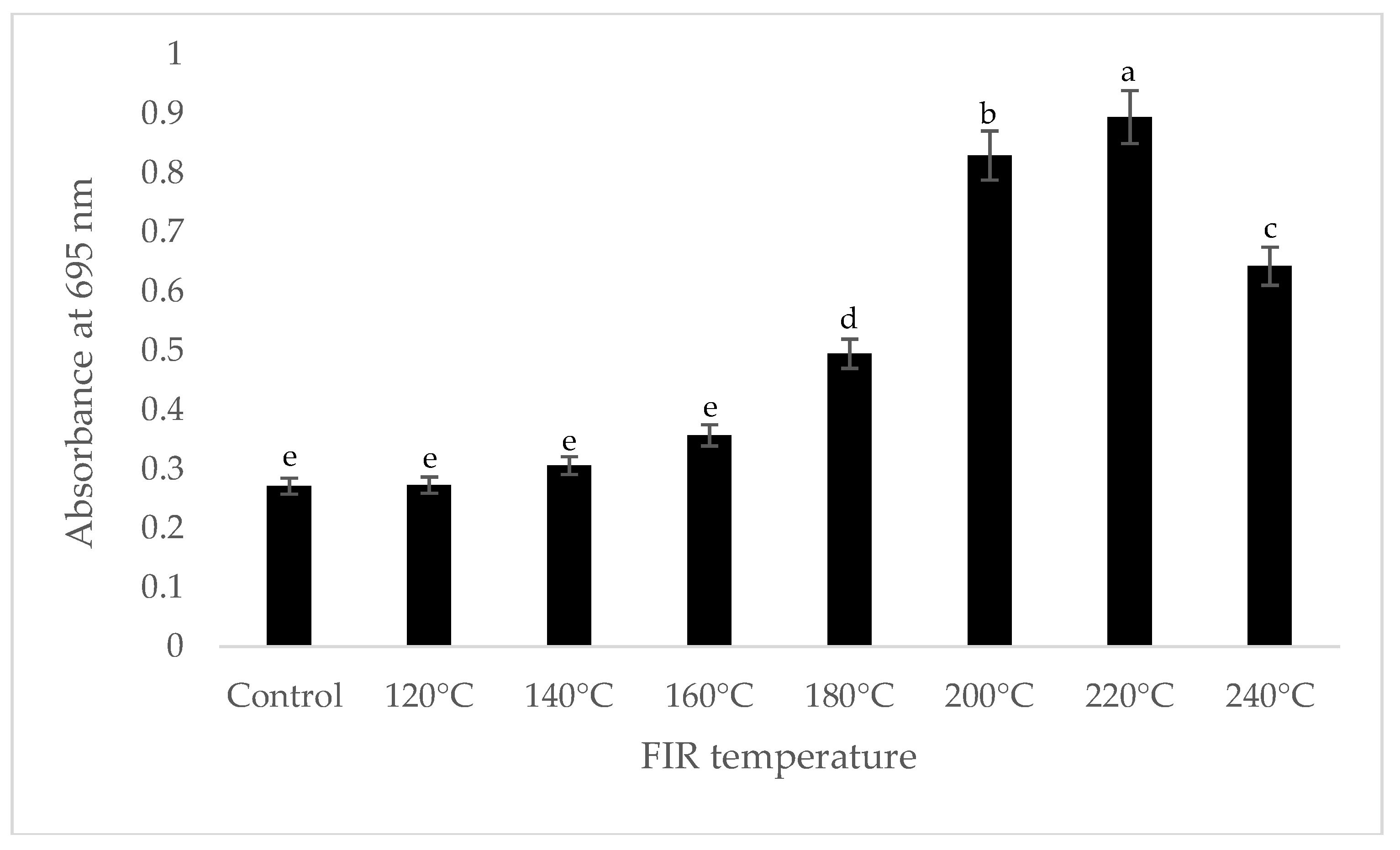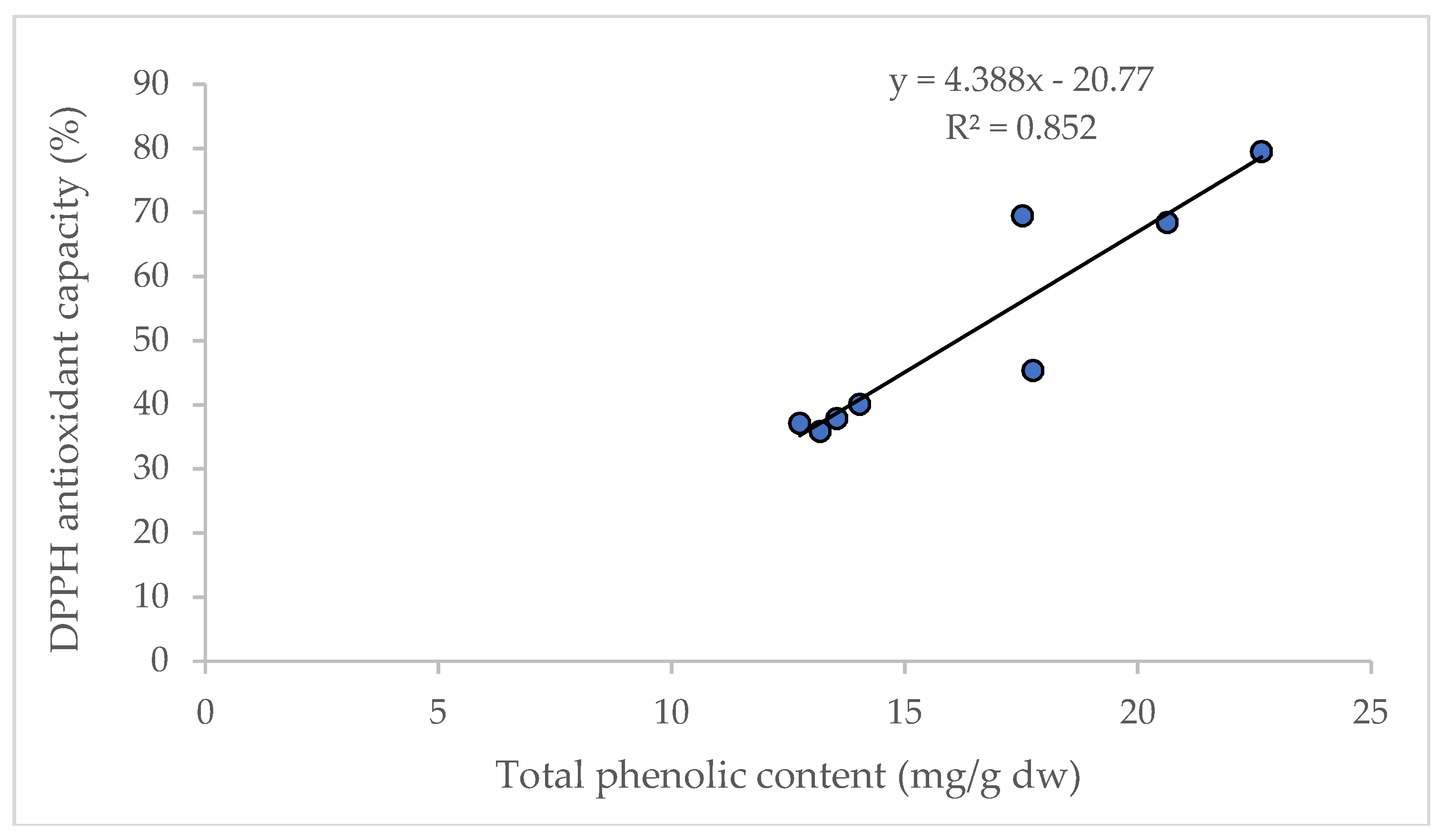Far Infrared Irradiation Enhances Nutraceutical Compounds and Antioxidant Properties in Angelica gigas Nakai Powder
Abstract
1. Introduction
2. Materials and Methods
2.1. Application of FIR Treatment and Preparation of AGN Extract
2.2. Estimation of Total Phenolic Content
2.3. Determination of Total Flavonoid Content
2.4. HPLC Analysis of AGN Extract with or without FIR Treatments
2.5. Antioxidant Capacity Analysis
2.5.1. DPPH Free Radical Scavenging Capacity
2.5.2. Ferric Reducing Antioxidant Power Assay (FRAP)
2.5.3. Phosphomolybdenum Method (PPMD)
3. Statistical Analysis
4. Results and Discussion
4.1. Effect of FIR Irradiation on Total Phenolic and Flavonoid Contents of AGN Powder
4.2. Effect of FIR Irradiation on Antioxidant Capacity of AGN Powder
5. Conclusions
Author Contributions
Funding
Conflicts of Interest
References
- Son, S.H.; Kim, M.J.; Chung, W.Y.; Son, J.A.; Kim, Y.S.; Kim, Y.C.; Kang, S.S.; Lee, S.K.; Park, K.K. Decursin and decursinol inhibit VEGF-induced angiogenesis by blocking the activation of extracellular signal-regulated kinase and c-Jun N terminal kinase. Cancer Lett. 2009, 280, 86–92. [Google Scholar] [CrossRef]
- Ahn, K.S.; Sim, W.S.; Lee, I.K.; Seu, Y.B.; Kim, I.H. Decursinol angelate: A cytotoxic and protein kinase C activating agent from the root of Angelica gigas. Planta Med. 1997, 63, 360–361. [Google Scholar] [CrossRef] [PubMed]
- Kim, D.H.; Jung, W.Y.; Park, S.J.; Kim, J.M.; Lee, S.J.; Kim, Y.C.; Ryu, J.H. Antiamnesic effect of ESP-102 on Ab1-42-induced memory impairment in mice. Pharmacol. Biochem. Behav. 2010, 97, 239–248. [Google Scholar] [CrossRef] [PubMed]
- Lee, S.; Lee, Y.S.; Jung, S.H.; Shin, K.H.; Kim, B.K.; Kang, S.S. Anti-tumor activities of decursinol angelate and decursin from Angelica gigas. Arch. Pharm. Res. 2003, 26, 727–730. [Google Scholar] [CrossRef] [PubMed]
- Joo, S.S.; Park, D.S.; Shin, S.H.; Jeon, J.H.; Kim, T.K.; Choi, Y.J.; Lee, S.H.; Kim, J.S.; Park, S.K.; Hwang, B.Y.; et al. Anti-allergic effects and mechanisms of action of the ethanolic extract of Angelica gigas in dinitrofluorobenzene induced inflammation models. Environ. Toxicol. Pharmacol. 2010, 30, 127–133. [Google Scholar] [CrossRef] [PubMed]
- Ahn, Q.; Jeong, S.J.; Lee, H.J.; Kwon, H.Y.; Han, I.; Kim, H.S.; Lee, H.J.; Lee, E.O.; Ahn, K.S.; Jung, M.H.; et al. Inhibition of cyclooxygenase-2-dependent surviv in mediates decursin-induced apoptosis in human KBM-5myeloid leukemia cells. Cancer Lett. 2010, 298, 212–221. [Google Scholar] [CrossRef]
- Sarker, S.; Naharl, D. Natural medicine: The genus Angelica. Curr. Med. Chem. 2004, 11, 1479–1500. [Google Scholar] [CrossRef] [PubMed]
- Khoddami, A.; Wilkes, M.A.; Robert, T.H. Techniques for analysis of plant phenolic compounds. Molecules 2013, 18, 2328–2375. [Google Scholar] [CrossRef]
- Peleg, H.; Naim, M.; Rouseff, R.L.; Zehavi, U. Distribution of bound and free phenolic acids in oranges (Citrus sinensis) and grapefruits (Citrus paradise). J. Sci. Food Agric. 1991, 57, 417–426. [Google Scholar] [CrossRef]
- Krishnamurthy, K.; Khurana, K.; Jun, S.; Irudayaraj, J.; Demirci, A. Infrared heating in food processing: An overview. Compr. Rev. Food Sci. Food Saf. 2008, 7, 2–13. [Google Scholar] [CrossRef]
- Kim, W.W.; Ghimeray, A.K.; Wu, J.C.; Eom, S.H.; Lee, B.G.; Kang, W.S.; Cho, D.H. Effect of far infrared drying on antioxidant property, anti-inflammatory activity, and inhibitory activity in A549 Cells of Gamguk (Chrysanthemum indicum L.) flower. Food Sci. Biotechnol. 2012, 21, 261–265. [Google Scholar] [CrossRef]
- Ghimeray, A.K.; Sharma, P.; Hu, W.; Cheng, W.; Park, C.H.; Rho, H.S.; Cho, D.H. Far infrared assisted conversion of isoflavones and its effect on total phenolics and antioxidant activity in black soybean seed. J. Med. Plants Res. 2013, 7, 1129–1137. [Google Scholar]
- Azad, M.O.K.; Kim, W.W.; Park, C.H.; Cho, D.H. Effect of artificial LED light and far infrared irradiation on phenolic compound, isoflavones and antioxidant capacity in soybean (Glycine max L.) sprout. Foods. 2018, 7, 174. [Google Scholar] [CrossRef] [PubMed]
- Jeong, S.M.; Kim, S.Y.; Kim, D.R.; Jo, S.C.; Nam, K.C.; Ahn, D.U. Effect of heat treatment on antioxidant activity of citrus peels. J. Agric. Food Chem. 2004, 52, 3389–3393. [Google Scholar] [CrossRef] [PubMed]
- Lee, S.; Kim, J.; Jeong, S.; Kim, D.; Ha, J.; Nam, K.; Ahn, D. Effect of far-infrared radiation on the antioxidant activity of rice hulls. J. Agric. Food Chem. 2003, 51, 4400–4403. [Google Scholar] [CrossRef] [PubMed]
- Singleton, V.L.; Rossi, J.A. Colorimetry of total phenolics with phosphor molybdic-phosphotungstic acid reagents. Am. J. Enol. Vitic. 1965, 16, 144–458. [Google Scholar]
- Braca, A.; Fico, G.; Morelli, I.; Simone, F.; Tome, F.; Tommasi, N. Antioxidant and free radical scavenging activity of flavonol glycosides from different Aconitum species. J. Ethnopharmacol. 2003, 8, 63–67. [Google Scholar] [CrossRef]
- Yu, L.; Zhao, M.; Wang, J.S.; Cui, C.; Yang, B.; Jiang, Y.; Zhao, Q. Antioxidant, immunomodulatory and anti-breast cancer activities of phenolic extract from pine (Pinusmassoniana Lamb) bark. Innov. Food Sci. Emerg. Technol. 2008, 9, 122–128. [Google Scholar] [CrossRef]
- Prieto, P.; Pineda, M.; Aguilar, M. Spectrophotometric quantitation of antioxidant capacity through the formation of a phosphomolybdenum complex: Specific application to the determination of vitamin E. Anal. Biochem. 1999, 269, 337–341. [Google Scholar] [CrossRef] [PubMed]
- Sandu, C. Infrared radiative drying in food engineering: A process analysis. Biotechnol. Prog. 1986, 2, 109–119. [Google Scholar] [CrossRef] [PubMed]
- Meeso, N. Far-infrared heating in paddy drying process. In New Food Engineering Research Trends; Urwaye, A.P., Ed.; Nova Science Publishers, Inc.: New York, NY, USA, 2008; pp. 225–256. [Google Scholar]
- Eom, S.H.; Park, H.J.; Seo, D.W.; Kim, W.W.; Cho, D.H. Stimulating effects of far infra-red ray radiation on the release of antioxidative phenolics in grape berries. Food Sci. Biotechnol. 2009, 18, 362–366. [Google Scholar]
- Adak, N.; Heybeli, N.; Ertekin, C. Infrared drying of strawberry. Food Chem. 2017, 219, 109–116. [Google Scholar] [CrossRef] [PubMed]
- Piluzza, G.; Bullitta, S. Correlations between phenolic content and antioxidant properties in twenty-four plant species of traditional ethnoveterinary use in the Mediterranean area. Pharm. Biol. 2011, 49, 240–247. [Google Scholar] [CrossRef] [PubMed]
- Sakanaka, S.; Tachibana, Y.; Okada, Y. Preparation and antioxidant properties of extracts of Japanese persimmon leaf tea (kakinohacha). Food Chem. 2005, 89, 569–575. [Google Scholar] [CrossRef]
- Prasad, K.N.; Yang, B.; Dong, X.; Jiang, G.; Zhang, H.; Xie, H.; Jiang, Y. Flavonoid contents and antioxidant activities from Cinnamomum species. Innov. Food Sci. Emerg. Technol. 2009, 10, 627–632. [Google Scholar] [CrossRef]
- Lee, K.K.; Oh, Y.C.; Cho, W.K.; Ma, J.Y. Antioxidant and anti-inflammatory activity determination of one hundred kinds of pure chemical compounds using offline and online screening HPLC assay. Evid. Complement. Altern. Med. 2015, 165457. [Google Scholar] [CrossRef]
- Cai, Y.Z.; Luo, Q.; Sun, M.; Corke, H. Antioxidant activity and phenolic compounds of 112 Chinese medicinal plants associated with anticancer. Life Sci. 2004, 74, 2157–2184. [Google Scholar] [CrossRef]
- Djeridane, A.; Yousfi, M.; Nadjemi, B.; Boutassouna, D.; Stocker, P.; Vidal, N. Antioxidant activity of some Algerian medicinal plants extracts containing phenolic compounds. Food Chem. 2006, 97, 654–660. [Google Scholar] [CrossRef]





| FIR Treatment | TP (mg/g GAE dw) | TF (mg/g CUE dw) |
|---|---|---|
| Control | 12.75 ± 0.25 e | 2.51 ± 0.07 c |
| 120 °C | 13.19 ± 0.26 d | 2.60 ± 0.05 c |
| 140 °C | 13.54 ± 0.54 d | 2.73 ± 0.11 c |
| 160 °C | 14.03 ± 0.28 d | 2.76 ± 0.08 c |
| 180 °C | 17.75 ± 0.53 c | 3.94± 0.07 c |
| 200 °C | 20.63 ± 0.41 b | 5.21 ± 0.15 b |
| 220 °C | 22.65 ± 0.22 a | 7.87 ± 0.14 a |
| 240 °C | 17.53 ± 0.35 c | 5.55 ± 0.16 b |
| FIR Treatment | Decursin (mg/g dw) | Decursinol Angelate (mg/g dw) |
|---|---|---|
| Control | 38.70 ± 2.11 d | 27.94 ± 1.28 c |
| 120 °C | 52.89 ± 1.89 c | 32.05 ± 0.92 bc |
| 140 °C | 53.12 ± 1.55 b | 32.14 ± 1.31 bc |
| 160 °C | 53.52 ± 1.05 b | 32.28 ± 0.95 bc |
| 180 °C | 54.27 ± 1.59 b | 33.51 ± 1.07 b |
| 200 °C | 55.01 ± 1.62 b | 34.21 ± 0.99 b |
| 220 °C | 62.48 ± 2.38 a | 41.51 ± 1.42 a |
| 240 °C | 56.32 ± 1.43 b | 36.05 ± 1.32 b |
© 2018 by the authors. Licensee MDPI, Basel, Switzerland. This article is an open access article distributed under the terms and conditions of the Creative Commons Attribution (CC BY) license (http://creativecommons.org/licenses/by/4.0/).
Share and Cite
Azad, M.O.K.; Piao, J.P.; Park, C.H.; Cho, D.H. Far Infrared Irradiation Enhances Nutraceutical Compounds and Antioxidant Properties in Angelica gigas Nakai Powder. Antioxidants 2018, 7, 189. https://doi.org/10.3390/antiox7120189
Azad MOK, Piao JP, Park CH, Cho DH. Far Infrared Irradiation Enhances Nutraceutical Compounds and Antioxidant Properties in Angelica gigas Nakai Powder. Antioxidants. 2018; 7(12):189. https://doi.org/10.3390/antiox7120189
Chicago/Turabian StyleAzad, Md Obyedul Kalam, Jing Pei Piao, Cheol Ho Park, and Dong Ha Cho. 2018. "Far Infrared Irradiation Enhances Nutraceutical Compounds and Antioxidant Properties in Angelica gigas Nakai Powder" Antioxidants 7, no. 12: 189. https://doi.org/10.3390/antiox7120189
APA StyleAzad, M. O. K., Piao, J. P., Park, C. H., & Cho, D. H. (2018). Far Infrared Irradiation Enhances Nutraceutical Compounds and Antioxidant Properties in Angelica gigas Nakai Powder. Antioxidants, 7(12), 189. https://doi.org/10.3390/antiox7120189






